|
Horseback riding vacations in
USA
North America, with its wide open
spaces and tradition of exploring the undiscovered, is still the ultimate
destination for horse lovers!
With hundreds of horse riding holidays and
horseback tour opportunities, the United States of America and Canada offer
cowboy tradition, vast wilderness and the genuine hospitality of the
guest and
working ranches
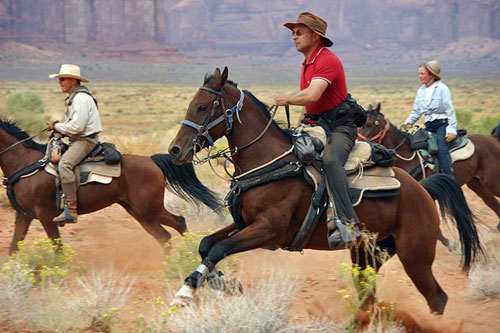
In North America it is easy to find a horseback
riding vacation to fulfill your lifelong dreams! Explore the Rocky
Mountains on a
wilderness pack trip,
drive a herd of horses in Idaho,
muster cattle on a working ranch in Montana, ride from inn to inn exploring
Utah - the list of the horse vacations available goes on and on, there are
far too many horse riding options to mention here!
Regardless of whether you
join Hidden Trails on a pack trip to faraway regions, riding from inn to inn,
work and play at a cattle or
guest ranch, or opt to combine your
horse
riding with fishing, the USA and Canada are the right places to look for
your adventure horse tour! of the
"Wild West".
Select by Horse Riding Activity:
Explore more
North
American Horse Riding Vacations
|
|
Holidays on horseback in USA
See Mini Country Guide
|
USA
Travel restrictions
Effective November 8th 2021, all non-immigrant, non-citizen air travelers to the United States will be required to be fully vaccinated and to provide proof of vaccination status prior to boarding an airplane to the United States.
As of June 12th 2022, the CDC will no longer order air passengers to show a negative COVID-19 test result, or show documentation of recovery from COVID-19, prior to boarding a flight to the United States. CDC’s Order requiring proof of vaccination for non-U.S. citizen nonimmigrants to travel to the United States is still in effect.
The CDC’s website explains that, for purposes of entry into the United States, the accepted vaccines will include FDA approved or authorized and WHO Emergency Use Listing vaccines. (Please see https://www.cdc.gov/coronavirus/2019-ncov/travelers/testing-international-air-travelers.html ).
Measures taken by the government
All travelers are required to wear a mask over their nose and mouth while in airplanes, airports, and other indoor areas of public transportation while traveling to, within, or out of the United States.
Individual state and local governments, as well as some businesses, may have their own health and safety guidelines regarding masks, social distancing, vaccination status, and more.
Emergency number (related to COVID-19) while visiting the country
Call 1-888-407-4747
Source:
VisitTheUSA.ca - U.S. COVID-19 Travel Guidelines
https://www.visittheusa.ca/us-covid-19-travel-guidelines
Checked on April 5th 2023
For more information please visit our COVID-19 Updates page at https://www.hiddentrails.com/article/covid19update.aspx
|
|
USA
At A glance
Capital City: Washington DC
Land size: 9,147,593 sq km
Population: 337,341,954 (2022 est.)
Official language: English
Currency: U.S. dollar ($ / USD)
UNESCO properties and sites:
- Cahokia Mounds State Historic Site
- Chaco Culture
- Independence Hall
- La Fortaleza and San Juan National Historic Site in Puerto Rico
- Mesa Verde National Park
- Monticello and the University of Virginia in Charlottesville
- Monumental Earthworks of Poverty Point
- San Antonio Missions
- Statue of Liberty
- Taos Pueblo
- The 20th-Century Architecture of Frank Lloyd Wright
- Carlsbad Caverns National Park
- Everglades National Park
- Grand Canyon National Park
- Great Smoky Mountains National Park
- Hawaii Volcanoes National Park
- Kluane / Wrangell-St. Elias / Glacier Bay / Tatshenshini-Alsek
- Mammoth Cave National Park
- Olympic National Park
- Redwood National and State Parks
- Waterton Glacier International Peace Park
- Yellowstone National Park
- Yosemite National Park
- Papahānaumokuākea
Source: https://www.cia.gov/the-world-factbook/countries/united-states/
From the iconic landmarks of Route 66 to the awe-inspiring natural wonders of Yellowstone National Park, the USA offers a tapestry of experiences that will leave you in awe. Explore the arid beauty of the Sonoran desert, immerse yourself in the heartland of Georgia, or experience cowboy life in an authentic working ranch.
Whether you seek adventure, culture, history, or natural beauty, the United States offers it all.
The USA offers a plethora of horseback riding opportunities for riders of all levels. Explore the majestic canyons and red rock formations of Utah on horseback, where the spirit of the Old West comes alive. Ride through the towering forests of California, breathing in the crisp mountain air as you meander along scenic trails. Immerse yourself in the cultural richness of the Southwest as you ride through the ancient landscapes of New Mexico.
Get ready to create lifelong memories as you connect with nature, experience the spirit of the American frontier, and embark on an unforgettable horseback riding adventure in the United States.
Brief History
Britain's American colonies broke with the mother country in 1776 and were recognized as the new nation of the United States of America following the Treaty of Paris in 1783. During the 19th and 20th centuries, 37 new states were added to the original 13 as the nation expanded across the North American continent and acquired a number of overseas possessions.
The two most traumatic experiences in the nation's history were the Civil War (1861-65), in which a northern Union of states defeated a secessionist Confederacy of 11 southern slave states, and the Great Depression of the 1930s, an economic downturn during which about a quarter of the labor force lost its jobs.
Since the end of World War II, the economy has achieved relatively steady growth, low unemployment and inflation, and rapid advances in technology.
Source: https://www.cia.gov/the-world-factbook/countries/united-states/
Cultural Insights
Personal comportment often appears loud, and effusive to people from other cultures, but Americans value emotional and bodily restraint. The permanent smile and unrelenting enthusiasm of the stereotypical American may mask strong emotions whose expression is not acceptable. Bodily restraint is expressed through the relatively large physical distance people maintain with each other, especially men.
Breast-feeding, yawning, and passing gas in public are considered rude. Americans consider it impolite to talk about money and age.
Source: https://www.everyculture.com/To-Z/United-States-of-America.html
Transportation
By Air
There are many access points to reach the USA, including more than 5,100 public airports. Not all airports serve international flights, but connections are readily available.
Top 10 U.S. airports by international arrivals
• John F. Kennedy International Airport, New York City, New York
• Miami International Airport, Miami, Florida
• Los Angeles International Airport, Los Angeles, California
• Newark Liberty International Airport New Jersey, serving the Greater New York City area
• Chicago O’Hare International Airport, Chicago, Illinois
• Hartsfield-Jackson Atlanta International Airport, Atlanta, Georgia
• San Francisco International Airport, San Francisco, California
• George Bush Intercontinental Airport, Houston, Texas
• Dulles International Airport, Virginia, serving the greater Washington, D.C. area
• Dallas/Fort Worth International Airport, Dallas, Texas
Once in the U.S., international travelers can fly between states on U.S. domestic airlines.
Source: https://www.visittheusa.ca/info/air-travel
Money
There are approximately 425,000 automated teller machines (ATMs) in the United States. Keep in mind, though, that you could be charged a variety of fees, including a non-bank ATM usage fee of up to $3 per use, ATM operator access fee and international transaction fee.
Check with your bank and credit card companies regarding fees before you travel. ATMs often offer the most competitive rates for currency conversion. Check the currency conversion rate before withdrawing money to make sure you are getting a fair exchange rate.
Credit cards are widely accepted throughout the U.S. for everything from hotels and dining to entertainment and public transportation. Depending on your credit card, you might be charged currency conversion and international transaction fees. Check with your credit card company prior to travel to keep these fees to a minimum.
Keep a photocopy of all your cards and international phone numbers for your credit card companies in a separate place from your credit cards in the event the cards are lost, stolen or stop working.
You should notify your bank about international travel before you depart to ensure your credit cards work properly upon arrival.
Merchants in the United States are in the process of switching to devices that can accommodate credit cards with the chip and PIN system, matching the technology used in Canada, Europe and elsewhere. Most retailers should be able to accommodate chip and pin credit cards by October 2015, though some smaller independent U.S. merchants may take longer to bring their systems in line. Some independent merchants do not accept credit cards, so it is best to check with merchants in advance to determine whether you need to withdraw cash.
Source: https://www.visittheusa.ca/info/shopping-spending-money
Health
If you need emergency medical assistance during your trip, dial 911 and ask for an ambulance. You should contact your insurance/medical assistance company promptly if you’re referred to a medical facility for treatment.
Medical treatment is expensive so make sure you have adequate travel health insurance and accessible funds to cover the cost of any medical treatment abroad and repatriation.
Some hospitals may ask non-US residents to pay a deposit or ‘good faith’ payment on admittance. You should direct any requests for funds to your travel insurance provider in the first instance; only pay the hospital if you’re advised to do so by your travel insurance company. Your level of medical care won’t be affected while your claim is being processed.
All major cities and towns have one or more hospitals. The front desks of most lodging facilities should have a list of local hospitals.
Health clinics and urgent care centers are designed to help patients with illnesses or injuries that are not life threatening. Many pharmacies also have walk-in clinics staffed by medical professionals. Hotel staff or your host can often direct you to such health centers.
Source: https://www.gov.uk/foreign-travel-advice/usa
https://www.visittheusa.ca/info/health-insurance-medical-treatment
Electricity
The USA operates on a 120V supply voltage and uses type A and B plugs.
The Type A electrical plug (or flat blade attachment plug) is an ungrounded plug with two flat parallel pins. Although the American and Japanese plugs appear identical, the neutral pin on the American plug is wider than the live pin, whereas on the Japanese plug both pins are the same size. As a result, Japanese plugs can be used in the US but often not the other way around.
The pins on Type A and Type B plugs have a hole near the tip that fits into ‘bumps’ found on the contact wipers of some sockets, so that the pins are gripped more tightly allowing for better contact and also to prevent the plug from slipping out of the socket. Some sockets have spring-action blades that grip the sides of the pins, making the holes obsolete.
The Type B electrical plug has two flat parallel pins and a round grounding (or earth) pin. The earth pin is longer than the other two so that the device is grounded before the power is connected. As with the type A plugs, the American and Japanese versions vary slightly.
Source: https://www.iec.ch/world-plugs
Communication
Time zones in the USA: Atlantic Time (GMT-4), Eastern Standard Time (GMT-5), Central Standard Time (GMT-6), Mountain Standard Time (GMT-7), Pacific Standard Time (GMT-8), Alaska Standard Time (GMT-9), Hawaii-Aleutian Time (GMT-10), Samoa Standard Time (GMT-11) and Chamorro Standard Time (GMT+10)
International country code – 1
The USA is one of the most wired countries in the world, especially in urban areas, making it relatively easy and affordable to stay communicate during your visit.
Free Wi-Fi is available at many coffee shops, restaurants and public libraries.
Many lodging facilities offer Wi-Fi for laptops, tablets and smartphones. Luxury hotels often charge for the service, while less expensive hotels often offer it for free. Some hotels only offer Wi-Fi access in their lobbies or have computers available in the lobbies for guest use.
Wi-Fi usually is available on trains, buses and airplanes. On U.S. domestic flights, passengers are allowed to use their computers, tablets, reading devices and smartphones as long as they are set to airplane mode.
Before traveling to the USA, check with your mobile phone carrier to see if your phone has international capability and whether it will operate on the Global System for Mobile (GSM) communications used in the U.S.
Using your mobile and data plan outside of your home network can be very costly. Even simply receiving email will impact your data charges. Many mobile phone carriers offer a variety of international plans that can save you money. If you choose not to get an international plan, you can turn off the data on your phone (or keep your phone in airplane mode) and simply log on to Wi-Fi networks; when they are available.
If you are in the USA for a long trip, you can purchase a dedicated phone or even a U.S. number at a mobile phone retailer.
Source: https://www.visittheusa.ca/info/communications-technology
Entry Requirements
All visitors from abroad who are planning to visit the USA must have a passport valid for at least six months longer than their intended stay in the U.S., unless they are exempted by country-specific agreements.
For families traveling together, each member of the family must have his or her own passport, including infants and children.
Depending on the issuer of your passport, a visa may be required for entry into the United States. A visa allows you to travel to a port of entry, an airport, land border crossing, or sea port, and request permission of the Department of Homeland Security (DHS), Customs and Border Protection (CBP) inspector to enter the United States. A U.S. consular officer will issue the visitor’s visa after determining that the applicant is eligible under a specific visa classification.
Your airline will give you documents to complete while en route to the USA. All foreign travelers to the USA are required to complete Customs Declaration Form 6059B and Form I-94 (white), Arrival/Departure Record.
Once you land, you must go through the CBP station for immigration and customs processing. CBP must approve your entry upon your port of entry in the USA. After passport control, gather any baggage you have and enter the U.S. Customs area.
All foreign travelers entering the USA by land are required to complete Customs Declaration Form 6059B and Form I-94 (white), Arrival/Departure Record. CBP will still issue a paper form I-94 at land border ports of entry.
Source: https://www.visittheusa.ca/info/official-travel-information
Embassies and Consulates
Embassy of Canada in Washington
501 Pennsylvania Avenue, N.W.
Washington, D.C., 20001
Phone: 1-844-880-6519
Consulate General of Canada in Atlanta
1175 Peachtree Street N.E., Suite 1700,
Atlanta, Georgia, 30361
Phone: 1-844-880-6519
Consulate General of Canada in Boston
3 Copley Place, Suite 400
Boston, Massachusetts, 02116
Phone: 1-844-880-6519
Consulate General of Canada in Chicago
Two Prudential Plaza, 180 North Stetson Avenue, Suite 2400
Chicago, Illinois, 60601
Phone: 1-844-880-6519
Consulate General of Canada in Dallas
500 N. Akard Street, Suite 2900
Dallas, Texas, 75201
Phone: 1-844-880-6519
Consulate General of Canada in Denver
1625 Broadway, Suite 2600
Denver, Colorado, 80202
Phone: 1-844-880-6519
Consulate General of Canada in Detroit
600 Renaissance Center, Suite 1100
Detroit, Michigan, 48243-1798
Phone: 1-844-880-6519
Consulate General of Canada in Honolulu
Penthouse Suite, 1000 Bishop Street
Honolulu, Hawaii, 96813-4299
Phone: 1-844-880-6519
Consulate General of Canada in Los Angeles
550 South Hope Street, 9th Floor
Los Angeles, California, 90071-2327
Phone: 1-844-880-6519
Consulate General of Canada in Miami
200 South Biscayne Boulevard, Suite 1600
Miami, Florida, 33131
Phone: 1-844-880-6519
Consulate General of Canada in Minneapolis
701 Fourth Avenue South, Suite 900
Minneapolis, Minnesota, 55415-1899
Phone: 1-844-880-6519
Consulate General of Canada in New York
466 Lexington Avenue, 20th Floor
New York, New York, 10017
Phone: 1-844-880-6519
Consulate General of Canada in San Francisco
580 California Street, 14th Floor
San Francisco, California, 94104
Phone: 1-844-880-6519
Consulate General of Canada in Seattle
1501 4th Ave, Suite 600
Seattle, Washington, 98101
Phone: 1-844-880-6519
Source: for Canada: https://travel.gc.ca/assistance/embassies-consulates
UNESCO Sites
Cahokia Mounds State Historic Site
Cahokia Mounds, some 13 km north-east of St Louis, Missouri, is the largest pre-Columbian settlement north of Mexico. It was occupied primarily during the Mississippian period (800–1400), when it covered nearly 1,600 ha and included some 120 mounds. It is a striking example of a complex chiefdom society, with many satellite mound centres and numerous outlying hamlets and villages. This agricultural society may have had a population of 10–20,000 at its peak between 1050 and 1150. Primary features at the site include Monks Mound, the largest prehistoric earthwork in the Americas, covering over 5 ha and standing 30 m high.
Chaco Culture
For over 2,000 years, Pueblo peoples occupied a vast region of the south-western United States. Chaco Canyon, a major centre of ancestral Pueblo culture between 850 and 1250, was a focus for ceremonials, trade and political activity for the prehistoric Four Corners area. Chaco is remarkable for its monumental public and ceremonial buildings and its distinctive architecture – it has an ancient urban ceremonial centre that is unlike anything constructed before or since. In addition to the Chaco Culture National Historical Park, the World Heritage property includes the Aztec Ruins National Monument and several smaller Chaco sites managed by the Bureau of Land Management.
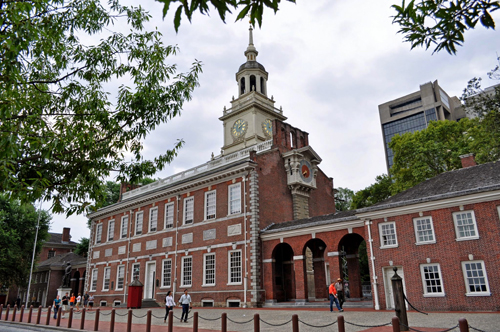
Photo by Camille Loiseau
Independence Hall
The Declaration of Independence (1776) and the Constitution of the United States (1787) were both signed in this building in Philadelphia. The universal principles of freedom and democracy set forth in these documents are of fundamental importance to American history and have also had a profound impact on law-makers around the world.
La Fortaleza and San Juan National Historic Site in Puerto Rico
Between the 16th and 20th centuries, a series of defensive structures was built at this strategic point in the Caribbean Sea to protect the city and the Bay of San Juan. They represent a fine display of European military architecture adapted to harbour sites on the American continent.
Mesa Verde National Park
A great concentration of ancestral Pueblo Indian dwellings, built from the 6th to the 12th century, can be found on the Mesa Verde plateau in south-west Colorado at an altitude of more than 2,600 m. Some 4,400 sites have been recorded, including villages built on the Mesa top. There are also imposing cliff dwellings, built of stone and comprising more than 100 rooms.
Monticello and the University of Virginia in Charlottesville
Thomas Jefferson (1743–1826), author of the American Declaration of Independence and third president of the United States, was also a talented architect of neoclassical buildings. He designed Monticello (1769–1809), his plantation home, and his ideal 'academical village' (1817–26), which is still the heart of the University of Virginia. Jefferson's use of an architectural vocabulary based upon classical antiquity symbolizes both the aspirations of the new American republic as the inheritor of European tradition and the cultural experimentation that could be expected as the country matured.
Monumental Earthworks of Poverty Point
Monumental Earthworks of Poverty Point owes its name to a 19th-century plantation close to the site, which is in the Lower Mississippi Valley on a slightly elevated and narrow landform. The complex comprises five mounds, six concentric semi-elliptical ridges separated by shallow depressions and a central plaza. It was created and used for residential and ceremonial purposes by a society of hunter fisher-gatherers between 3700 and 3100 BP. It is a remarkable achievement in earthen construction in North America that was unsurpassed for at least 2,000 years.
San Antonio Missions
The site encompasses a group of five frontier mission complexes situated along a stretch of the San Antonio River basin in southern Texas, as well as a ranch located 37 kilometres to the south. It includes architectural and archaeological structures, farmlands, residencies, churches and granaries, as well as water distribution systems. The complexes were built by Franciscan missionaries in the 18th century and illustrate the Spanish Crown’s efforts to colonize, evangelize and defend the northern frontier of New Spain. The San Antonio Missions are also an example of the interweaving of Spanish and Coahuiltecan cultures, illustrated by a variety of features, including the decorative elements of churches, which combine Catholic symbols with indigenous designs inspired by nature.

Photo by Camille Loiseau
Statue of Liberty
Made in Paris by the French sculptor Bartholdi, in collaboration with Gustave Eiffel (who was responsible for the steel framework), this towering monument to liberty was a gift from France on the centenary of American independence. Inaugurated in 1886, the sculpture stands at the entrance to New York Harbour and has welcomed millions of immigrants to the United States ever since.
Taos Pueblo
Situated in the valley of a small tributary of the Rio Grande, this adobe settlement – consisting of dwellings and ceremonial buildings – represents the culture of the Pueblo Indians of Arizona and New Mexico.
The 20th-Century Architecture of Frank Lloyd Wright
The property consists of eight buildings in the United States designed by the architect during the first half of the 20th century. These include well known designs such as Fallingwater (Mill Run, Pennsylvania) and the Guggenheim Museum (New York). All the buildings reflect the ‘organic architecture’ developed by Wright, which includes an open plan, a blurring of the boundaries between exterior and interior and the unprecedented use of materials such as steel and concrete. Each of these buildings offers innovative solutions to the needs for housing, worship, work or leisure. Wright's work from this period had a strong impact on the development of modern architecture in Europe.
Carlsbad Caverns National Park
This karst landscape in the state of New Mexico comprises over 80 recognized caves. They are outstanding not only for their size but also for the profusion, diversity and beauty of their mineral formations. Lechuguilla Cave stands out from the others, providing an underground laboratory where geological and biological processes can be studied in a pristine setting.
Everglades National Park
This site at the southern tip of Florida has been called 'a river of grass flowing imperceptibly from the hinterland into the sea'. The exceptional variety of its water habitats has made it a sanctuary for a large number of birds and reptiles, as well as for threatened species such as the manatee.
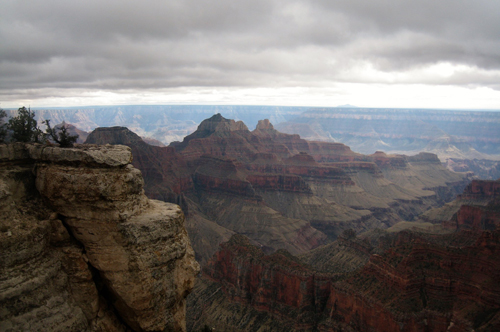
Grand Canyon National Park
Carved out by the Colorado River, the Grand Canyon (nearly 1,500 m deep) is the most spectacular gorge in the world. Located in the state of Arizona, it cuts across the Grand Canyon National Park. Its horizontal strata retrace the geological history of the past 2 billion years. There are also prehistoric traces of human adaptation to a particularly harsh environment.
Great Smoky Mountains National Park
Stretching over more than 200,000 ha, this exceptionally beautiful park is home to more than 3,500 plant species, including almost as many trees (130 natural species) as in all of Europe. Many endangered animal species are also found there, including what is probably the greatest variety of salamanders in the world. Since the park is relatively untouched, it gives an idea of temperate flora before the influence of humankind.
Hawaii Volcanoes National Park
This site contains two of the most active volcanoes in the world, Mauna Loa (4,170 m high) and Kilauea (1,250 m high), both of which tower over the Pacific Ocean. Volcanic eruptions have created a constantly changing landscape, and the lava flows reveal surprising geological formations. Rare birds and endemic species can be found there, as well as forests of giant ferns.
Kluane / Wrangell-St. Elias / Glacier Bay / Tatshenshini-Alsek
These parks comprise an impressive complex of glaciers and high peaks on both sides of the border between Canada (Yukon Territory and British Columbia) and the United States (Alaska). The spectacular natural landscapes are home to many grizzly bears, caribou and Dall's sheep. The site contains the largest non-polar icefield in the world.
Mammoth Cave National Park
Mammoth Cave National Park, located in the state of Kentucky, has the world's largest network of natural caves and underground passageways, which are characteristic examples of limestone formations. The park and its underground network of more than 560 surveyed km of passageways are home to a varied flora and fauna, including a number of endangered species.
Olympic National Park
Located in the north-west of Washington State, Olympic National Park is renowned for the diversity of its ecosystems. Glacier-clad peaks interspersed with extensive alpine meadows are surrounded by an extensive old growth forest, among which is the best example of intact and protected temperate rainforest in the Pacific Northwest. Eleven major river systems drain the Olympic mountains, offering some of the best habitat for anadromous fish species in the country. The park also includes 100 km of wilderness coastline, the longest undeveloped coast in the contiguous United States, and is rich in native and endemic animal and plant species, including critical populations of the endangered northern spotted owl, marbled murrelet and bull trout.
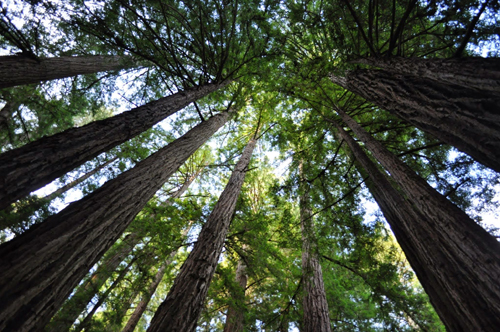
Photo by Camille Loiseau
Redwood National and State Parks
Redwood National Park comprises a region of coastal mountains bordering the Pacific Ocean north of San Francisco. It is covered with a magnificent forest of coastal redwood trees, the tallest and most impressive trees in the world. The marine and land life are equally remarkable, in particular the sea lions, the bald eagle and the endangered California brown pelican.
Waterton Glacier International Peace Park
In 1932 Waterton Lakes National Park (Alberta, Canada) was combined with the Glacier National Park (Montana, United States) to form the world's first International Peace Park. Situated on the border between the two countries and offering outstanding scenery, the park is exceptionally rich in plant and mammal species as well as prairie, forest, and alpine and glacial features.
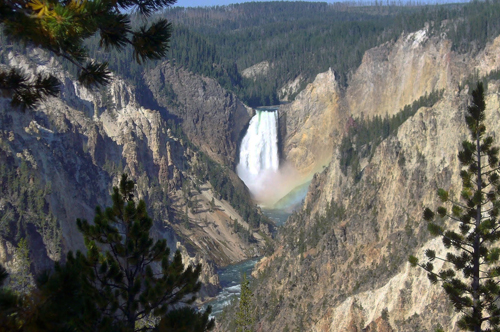
Photo by Camille Loiseau
Yellowstone National Park
The vast natural forest of Yellowstone National Park covers nearly 9,000 km2 ; 96% of the park lies in Wyoming, 3% in Montana and 1% in Idaho. Yellowstone contains half of all the world's known geothermal features, with more than 10,000 examples. It also has the world's largest concentration of geysers (more than 300 geyers, or two thirds of all those on the planet). Established in 1872, Yellowstone is equally known for its wildlife, such as grizzly bears, wolves, bison and wapitis.
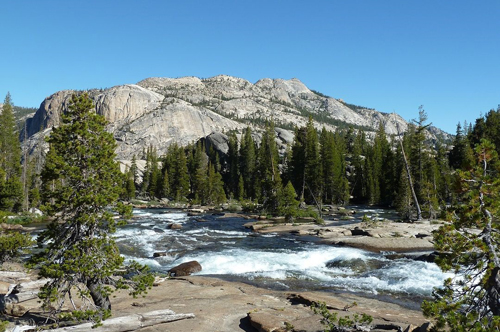
Yosemite National Park
Yosemite National Park lies in the heart of California. With its 'hanging' valleys, many waterfalls, cirque lakes, polished domes, moraines and U-shaped valleys, it provides an excellent overview of all kinds of granite relief fashioned by glaciation. At 600–4,000 m, a great variety of flora and fauna can also be found here.
Papahānaumokuākea
Papahānaumokuākea is a vast and isolated linear cluster of small, low lying islands and atolls, with their surrounding ocean, roughly 250 km to the northwest of the main Hawaiian Archipelago and extending over some 1931 km. The area has deep cosmological and traditional significance for living Native Hawaiian culture, as an ancestral environment, as an embodiment of the Hawaiian concept of kinship between people and the natural world, and as the place where it is believed that life originates and to where the spirits return after death. On two of the islands, Nihoa and Makumanamana, there are archaeological remains relating to pre-European settlement and use. Much of the monument is made up of pelagic and deepwater habitats, with notable features such as seamounts and submerged banks, extensive coral reefs and lagoons. It is one of the largest marine protected areas (MPAs) in the world.
Source: https://whc.unesco.org/en/statesparties/us
|
|